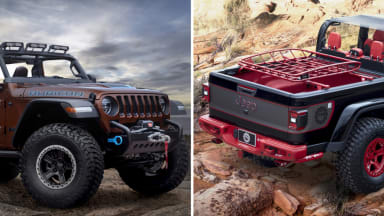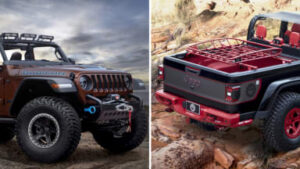
Jeep Parts That Increase Your Vehicle’s Value
A Jeep’s battery gets all the attention, but without a functioning alternator, your Jeep would be nothing more than a driveway decoration. JEGS stocks a large selection of Jeep parts that can help increase your vehicle’s value with well-chosen upgrades and replacements.
OEM Mopar parts are made by your car’s original maker and offer consistent specifications from part to part. This makes them the most reliable replacement parts available.
The radiator in your Jeep is the primary component that cools your engine. It does this by cycling thermal energy from the engine itself, which can reach temperatures that could damage internal components such as the cylinder walls, pistons, and engine head. The radiator absorbs this heat, and the liquid that goes through it is cooled by a series of thin metal fins, which help disperse the heat into the air. Once the coolant passes through these fins, it recirculates to your engine, where it absorbs more heat, and the cycle repeats itself.
Your radiator consists of two tanks that hold your coolant at its inlet and outlet. A core sits between these tanks, and it has tubes that run through it. These tubes are attached to the cooling fins, which disperse the heat into the air. These fins are also attached to a fan, which can be mechanical or electric. The fan helps move the cooler air around the radiator to aid in heat transfer, and it will switch on at low vehicle speeds. At highway speeds, it isn’t required to be on, as the air flow through your cooling system is sufficient.
Other parts of the cooling system include a thermostat and pressure cap. The thermostat helps ensure that the coolant reaches your engine’s operating temperature, which is important for maintaining proper gas mileage and performance. The pressure cap helps seal the coolant in the radiator to keep it under pressure, which helps prevent it from boiling and overflowing.
A faulty radiator can cause your engine to overheat, which is dangerous for the internal components and the environment. The best way to avoid overheating is to regularly inspect your cooling system for signs of leaks or other issues. Checking your coolant levels, repairing or replacing hoses, and having the radiator flushed with an approved solution are all important steps in keeping it in good working condition.
Over time, the cooling system can accumulate internal sludge from contaminants, which reduces its ability to work efficiently. Having the cooling system flushed every 25,000 miles can remove these contaminants and ensure that your radiator is able to function at its full potential. Adding an engine oil cooler and a transmission coolant cooler can further improve your Jeep’s cooling system, making it more efficient than ever before.
A/C Compressor
The compressor is the heart of your air conditioning system. It is belt-driven and increases the pressure of the refrigerant in the A/C system, forcing it to circulate through the evaporator and condenser. It also changes the state of the refrigerant from gaseous to liquid. Once the refrigerant passes through these two components, it absorbs the heat from the cabin of your vehicle and becomes cold. The refrigerant then moves to the expansion valve or orifice tube, where it is changed back to a gaseous state and sent to your cabin as cold air through vents.
The A/C compressor also contains a clutch that is used to switch the system on and off when you use the air conditioner. This allows the engine to stop turning the compressor, so it doesn’t wear out as fast. However, this clutch can fail as a result of age or excessive stress.
A bad clutch can cause the system to not function, but it can also make the engine turn too hard, which can destroy the compressor bearings. Other signs of a compressor problem include weird noises or a leaking clutch. If you are mechanically inclined, you can repair your compressor by replacing its clutch pulley, but this is a complicated and risky job.
Another common sign that your compressor is going out is when it fails to compress the refrigerant and sends it to the evaporator. A bad accumulator can also cause this problem. If your accumulator has become full of dirt and moisture, it won’t be able to trap the cold air it is supposed to send, and you will have no A/C. It is important to keep your accumulator topped off with refrigerant to prevent this from happening. You can check the condition of your accumulator by looking at its front pulley with the engine running. If there is any slop or play in the pulley, it is likely time to replace it. This can also help you determine if the compressor clutch is bad, in which case it is best to replace both parts at once.
Air Filter
An air filter is a very important part of any vehicle. It helps to keep the outside air from entering your vehicle’s engine, allowing you to control the temperature in your cabin without being exposed to allergens, dust, and other debris. This can help to keep the interior of your vehicle clean and comfortable, and it can also reduce asthma- and allergy-related symptoms.
Air filters can be found on the engine and in your HVAC system. Both need to be replaced regularly, according to the manufacturer’s maintenance schedule. A dirty filter can restrict the flow of oxygen to your engine, which can cause damage and reduce fuel efficiency. An air filter is typically a small, pleated unit that is made from paper-based, multifiber cotton, or an engineered material. Before the air can enter your passenger cabin, it must go through the filter, which helps to remove contaminants.
A clean air filter allows the fuel to burn properly, reducing engine emissions and increasing the gas mileage of your vehicle. This can save you money at the pump. The air filter can also protect your car from clogged spark plugs, which can damage the engine and decrease its performance.
Most vehicles need their engine air filters replaced every 12,000 miles, but this can vary between makes and models. Some manufacturers suggest that you change the air filter more frequently, depending on driving conditions.
Your air filter can be easy to replace, but you may need to consult your owner’s manual for instructions on how to access the filter. The filter is usually located behind the glove box, and you can remove it by removing the fasteners. It is recommended that you inspect the air filter regularly for signs of wear and tear, such as soot, dust, leaves, or twigs, that could indicate that it is time to replace it.
You can buy a replacement air filter from a Jeep dealership or online. An online retailer can offer you a great deal on an air filter for your Jeep Wrangler and deliver it directly to your home.
Fuel Pump
The fuel pump is a car part that sends gas from the tank to the engine so your vehicle can move and function. It’s an electrically or mechanically controlled device that is designed to last 100,000 miles or more, but it does wear out eventually and needs to be replaced. When the fuel pump starts to fail, there are often several warning signs that your mechanic will detect before the car suddenly stops running.
The most obvious symptom is that the car is taking longer to start. As the fuel pump fails, it takes more cranks to get the engine to rev, so the starter motor has to work harder to keep up and burns more fuel. A whining noise is another sign that the fuel pump is starting to die. Usually, the pump produces a low humming noise as it distributes fuel to the engine, but a whining sound indicates that it isn’t doing its job properly.
A failing fuel pump is also likely to produce an inaccurate signal to the fuel gauge. The faulty reading means that the gas gauge is likely overstating how much fuel is in your tank, and it can be dangerous to drive with this problem. The solution is to replace the fuel pump and fuel-level sensor, which are typically installed together in a pump module.
Driving hard or towing heavy loads puts a lot of strain on the fuel pump, and it can fail when this demand is too great. This occurrence is especially common when the vehicle isn’t maintained regularly, and it’s easy for the pump to wear out prematurely.
If you are having trouble with your vehicle’s fuel pump, check out our selection of Jeep parts to find the correct replacement and install it correctly. We offer a variety of different sizes, styles, and colors to suit any vehicle. You can shop online and have the parts delivered to your door, or stop by one of our local Advance Auto Parts locations for professional help with your installation. Shipping your vehicle when you’re not using it can help prevent unnecessary wear on the fuel pump and other components, too. Contact Mercury Auto Transport today to learn more about our services and to find the ideal carrier for your vehicle.
